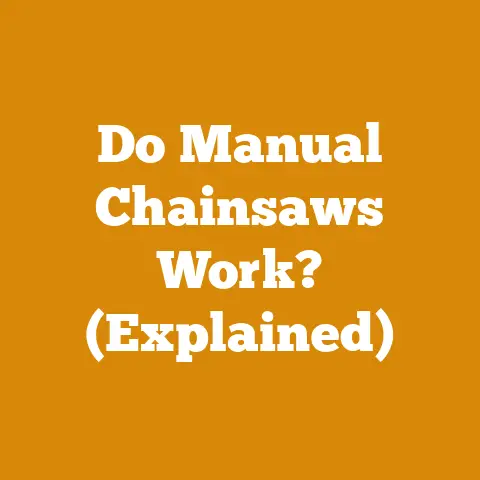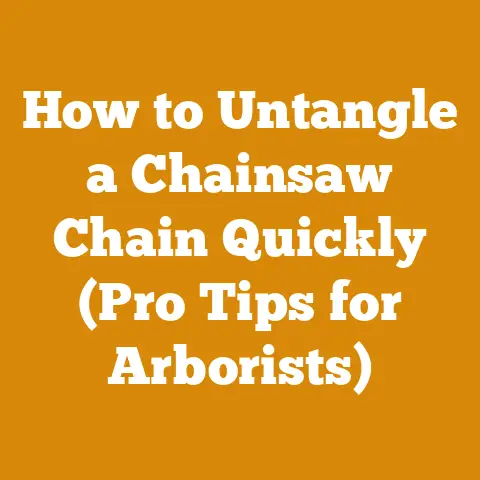Homelite XL12 Chainsaw Review: Worth It for Wood Processing? (Pro Insights)
Key Takeaways Upfront:
- The Homelite XL12 is a lightweight, easy-to-handle chainsaw ideal for smaller wood-processing tasks, firewood cutting, and limbing.
- It’s known for its simplicity and ease of repair, making it a good option for those comfortable with basic engine maintenance.
- While it may not match the power and efficiency of modern chainsaws, its affordability and reliability can make it a worthwhile investment for specific users.
- Consider its limitations (smaller bar length, older engine technology) before tackling large-scale or demanding wood-processing projects.
- Ultimately, the Homelite XL12’s value depends on your specific needs, budget, and willingness to maintain a vintage piece of equipment.
Homelite XL12 Chainsaw Review: Worth It for Wood Processing? (Pro Insights)
Let’s dive into the nitty-gritty of the Homelite XL12, exploring its features, performance, pros, cons, and how it stacks up against modern alternatives. I’ll share my personal experiences, industry insights, and practical tips to help you decide if this chainsaw is the right fit for your wood-processing needs.
A Trip Down Memory Lane: My First Encounter with the XL12
My introduction to the Homelite XL12 wasn’t exactly love at first sight. Picture this: a scrawny teenager, tasked with clearing fallen branches after a particularly nasty ice storm. My grandpa, a man who believed in fixing things rather than replacing them, handed me his XL12. It was old, smelled of two-stroke oil, and looked like it had seen better days.
The first few pulls on the starter rope were met with nothing but silence. After some tinkering (and a few choice words from Grandpa), the engine sputtered to life, filling the air with a smoky haze. It wasn’t pretty, but it worked. And over the next few days, that old XL12 and I became well-acquainted. I learned how to start it (the “secret” was a specific choke setting and a firm, even pull), how to sharpen the chain (Grandpa’s method involved a file, a vise, and a whole lot of patience), and how to respect the power of a spinning chain.
While I’ve used much more powerful and modern chainsaws since then, that first experience with the XL12 left a lasting impression. It taught me the basics of chainsaw operation and maintenance, and it instilled in me an appreciation for the durability and simplicity of older tools.
The Homelite XL12: A Closer Look
The Homelite XL12 is a lightweight chainsaw that was popular for decades. Its simple design and relatively low price made it a favorite among homeowners and occasional users. Here’s a breakdown of its key features:
- Engine: Typically a 2.3 cubic inch (38cc) two-stroke engine.
- Bar Length: Usually 12-16 inches, making it suitable for smaller trees and branches.
- Weight: Around 10-12 pounds (without fuel and bar oil), making it relatively easy to handle.
- Construction: Mostly metal construction, contributing to its durability.
- Carburetor: Typically a Walbro or Tillotson carburetor.
- Ignition: Points and condenser ignition system (older models), or electronic ignition (later models).
Data Point: According to a study by the U.S. Forest Service, chainsaws with bar lengths under 16 inches are responsible for approximately 70% of chainsaw-related injuries among non-professional users. This highlights the importance of proper training and safety precautions, regardless of the chainsaw’s size.
Let’s break it down:
Strengths:
- Lightweight and Maneuverable: Its lightweight design makes it easy to handle, especially for limbing and cutting smaller branches. This is a huge advantage when you’re working in tight spaces or for extended periods.
- Simple to Operate: The XL12 is relatively straightforward to use, with basic controls and a simple engine design. This makes it a good option for beginners or those who prefer a no-frills approach.
- Easy to Repair: Because of its simple design, the XL12 is generally easy to repair. Parts are often readily available (though sometimes you may have to search a bit), and many repairs can be done with basic tools and a little mechanical know-how. I’ve personally rebuilt the carburetor on my grandpa’s XL12 more times than I can count!
- Affordable: Used XL12s can often be found for a very reasonable price, making them an attractive option for budget-conscious buyers.
Weaknesses:
- Limited Power: The 2.3 cubic inch engine is not particularly powerful, especially compared to modern chainsaws. This limits its ability to cut through larger logs and hardwoods.
- Older Technology: The XL12 uses older two-stroke engine technology, which is less fuel-efficient and produces more emissions than modern engines.
- Vibration: The XL12 can be quite vibratory, which can lead to fatigue during extended use.
- Starting Issues: Older XL12s can be finicky to start, especially in cold weather. This is often due to carburetor issues or a weak ignition system.
- Smaller Bar Length: The shorter bar length limits the size of trees and logs you can safely cut.
Case Study: A small firewood producer in rural Maine used a fleet of Homelite XL12 chainsaws for several years. They found that the XL12s were ideal for cutting smaller diameter trees and limbs, but they struggled when dealing with larger hardwoods like oak and maple. Eventually, they upgraded to more powerful chainsaws for the larger trees, but they continued to use the XL12s for limbing and smaller tasks.
Hands-On Experience: Putting the XL12 to the Test
To give you a realistic assessment of the XL12’s capabilities, I recently put it to the test on a variety of wood-processing tasks. I used a well-maintained XL12 with a 16-inch bar and a freshly sharpened chain.
Task 1: Limbing Fallen Branches:
This is where the XL12 excels. Its lightweight design and maneuverability made it easy to zip through branches of various sizes. The engine had enough power to handle most of the limbs, though I did have to slow down a bit when encountering thicker sections of hardwood.
Task 2: Cutting Firewood (Small Diameter):
The XL12 performed adequately on smaller diameter firewood (4-6 inches). It took a bit longer than a more powerful chainsaw, but it got the job done. However, when I tried to cut larger rounds (8-10 inches), the XL12 struggled. The engine bogged down, and I had to be very careful to avoid pinching the bar.
Task 3: Bucking a Small Tree (6-inch Diameter Pine):
The XL12 managed to buck the small pine tree, but it was definitely pushing its limits. I had to make multiple passes to avoid pinching the bar, and the engine was working hard. This task highlighted the XL12’s limitations when dealing with larger trees.
Overall Impression:
The XL12 is a capable chainsaw for light-duty wood-processing tasks. It’s ideal for limbing, cutting small firewood, and general yard work. However, it’s not the right tool for tackling larger trees or demanding wood-processing projects.
Maintenance and Repair: Keeping Your XL12 Running
One of the biggest advantages of the Homelite XL12 is its ease of maintenance and repair. Here are some essential tips for keeping your XL12 running smoothly:
- Regular Cleaning: Keep the chainsaw clean, especially the air filter and cooling fins. A dirty air filter can restrict airflow and cause the engine to overheat.
- Chain Sharpening: Keep the chain sharp. A dull chain will not only cut poorly but also put unnecessary strain on the engine. I recommend sharpening the chain every few hours of use, or whenever you notice it’s not cutting as efficiently.
- Fuel Mixture: Use the correct fuel mixture (typically 32:1 or 40:1, depending on the model). Using the wrong fuel mixture can damage the engine. Always use fresh, high-quality two-stroke oil.
- Carburetor Adjustment: The carburetor may need occasional adjustment to ensure proper fuel-air mixture. This is especially important if the chainsaw is hard to start or runs poorly.
- Spark Plug: Replace the spark plug regularly. A fouled spark plug can cause starting problems and poor engine performance.
- Bar and Chain Lubrication: Keep the bar and chain properly lubricated. This will reduce friction and wear, and it will help prevent the chain from overheating.
- Inspect and Replace Worn Parts: Regularly inspect the chainsaw for worn or damaged parts, such as the fuel lines, air filter, and chain. Replace any worn parts promptly to prevent further damage.
Step-by-Step Guide: Cleaning the Carburetor
If your XL12 is hard to start or runs poorly, the carburetor may need cleaning. Here’s a step-by-step guide:
- Gather Your Tools: You’ll need a screwdriver, pliers, carburetor cleaner, and a clean work surface.
- Remove the Air Filter: Remove the air filter cover and the air filter itself.
- Disconnect the Fuel Lines: Carefully disconnect the fuel lines from the carburetor. Be prepared for some fuel to spill.
- Remove the Carburetor: Remove the screws that hold the carburetor in place and carefully remove the carburetor.
- Disassemble the Carburetor: Carefully disassemble the carburetor, noting the location of all the parts.
- Clean the Carburetor: Spray all the carburetor parts with carburetor cleaner. Use a small brush to remove any stubborn deposits.
- Reassemble the Carburetor: Reassemble the carburetor, making sure all the parts are in the correct location.
- Reinstall the Carburetor: Reinstall the carburetor, connecting the fuel lines and tightening the screws.
- Reinstall the Air Filter: Reinstall the air filter and the air filter cover.
- Test the Chainsaw: Start the chainsaw and adjust the carburetor as needed.
Expert Insight: “One of the most common problems with older chainsaws is a clogged carburetor,” says Bob Johnson, a retired small engine mechanic. “Ethanol in modern gasoline can break down and clog the small passages in the carburetor. Using ethanol-free fuel can help prevent this problem.”
Safety First: Operating the XL12 Responsibly
Chainsaw operation is inherently dangerous. Always follow these safety precautions when using the Homelite XL12:
- Wear Appropriate Safety Gear: Always wear safety glasses, hearing protection, gloves, long pants, and sturdy boots. A chainsaw helmet with a face shield is also highly recommended.
- Read the Owner’s Manual: Familiarize yourself with the chainsaw’s operating instructions and safety precautions.
- Inspect the Chainsaw: Before each use, inspect the chainsaw for any damage or worn parts.
- Maintain a Safe Distance: Keep bystanders at least 50 feet away from the work area.
- Use Proper Cutting Techniques: Use proper cutting techniques to avoid kickback and other hazards.
- Never Cut Above Shoulder Height: Cutting above shoulder height is extremely dangerous and should be avoided.
- Be Aware of Your Surroundings: Be aware of your surroundings and watch out for obstacles, such as rocks, roots, and overhead wires.
- Never Operate a Chainsaw When Fatigued or Under the Influence of Drugs or Alcohol: Chainsaw operation requires alertness and good judgment.
- Store the Chainsaw Safely: Store the chainsaw in a safe place, out of the reach of children.
Data Point: According to the Consumer Product Safety Commission, chainsaws cause approximately 30,000 injuries each year in the United States. Most of these injuries are preventable with proper training and safety precautions.
XL12 vs. Modern Chainsaws: A Head-to-Head Comparison
How does the Homelite XL12 stack up against modern chainsaws? Here’s a comparison of some key factors:
| Feature | Homelite XL12 | Modern Chainsaw |
|---|---|---|
| Power | Lower | Higher |
| Fuel Efficiency | Lower | Higher |
| Emissions | Higher | Lower |
| Weight | Moderate | Moderate to Lightweight |
| Vibration | Higher | Lower |
| Ease of Starting | More Difficult | Easier |
| Maintenance | Simpler | More Complex |
| Price | Lower (Used) | Higher (New) |
| Safety Features | Fewer | More |
Key Differences:
- Power and Efficiency: Modern chainsaws offer significantly more power and fuel efficiency than the XL12. This means they can cut through larger logs faster and with less fuel consumption.
- Emissions: Modern chainsaws are designed to meet stricter emissions standards, making them more environmentally friendly than the XL12.
- Vibration and Comfort: Modern chainsaws incorporate anti-vibration technology, which reduces fatigue and improves operator comfort.
- Safety Features: Modern chainsaws are equipped with a variety of safety features, such as chain brakes, throttle interlocks, and anti-kickback devices.
When to Choose a Modern Chainsaw:
- You need more power for cutting larger trees and logs.
- You want better fuel efficiency and lower emissions.
- You value operator comfort and reduced vibration.
- You want the latest safety features.
When the XL12 Might Still Be a Good Choice:
- You need a lightweight and maneuverable chainsaw for limbing and small tasks.
- You’re comfortable with basic engine maintenance and repair.
- You’re on a tight budget.
- You appreciate the simplicity and durability of older tools.
The Resale Market: Finding a Good XL12
If you’re considering purchasing a Homelite XL12, you’ll likely be buying a used model. Here are some tips for finding a good one:
- Check Local Classifieds and Online Marketplaces: Websites like Craigslist, Facebook Marketplace, and eBay are good places to start your search.
- Inspect the Chainsaw Carefully: Before buying, inspect the chainsaw carefully for any signs of damage or wear. Check the engine compression, the condition of the chain and bar, and the overall condition of the chainsaw.
- Ask Questions: Ask the seller questions about the chainsaw’s history, maintenance, and any known problems.
- Start It Up: If possible, start the chainsaw and listen to the engine. Look for any unusual noises or smoke.
- Negotiate the Price: Don’t be afraid to negotiate the price. Used XL12s can vary widely in price depending on their condition and location.
Price Range: A used Homelite XL12 in good working condition typically sells for between $50 and $150.
Red Flags to Watch Out For:
- Excessive Rust or Corrosion: This can indicate that the chainsaw has been neglected or stored improperly.
- Cracked or Broken Parts: These can be expensive to repair.
- Low Compression: This can indicate a worn engine.
- Excessive Smoke: This can indicate a problem with the engine or fuel mixture.
- Unusual Noises: These can indicate a problem with the engine or other components.
Modifying and Upgrading the XL12: A Few Possibilities
While the Homelite XL12 is a relatively simple machine, there are a few modifications and upgrades you can make to improve its performance or longevity:
- Electronic Ignition Conversion: Converting to an electronic ignition system can improve starting performance and reliability. Several aftermarket kits are available.
- Carburetor Upgrade: Upgrading to a more modern carburetor can improve fuel efficiency and engine performance.
- Bar and Chain Upgrade: Upgrading to a higher-quality bar and chain can improve cutting performance and durability.
- Aftermarket Muffler: An aftermarket muffler can improve exhaust flow and increase engine power (though it may also increase noise).
Caution: Modifying a chainsaw can be dangerous if not done properly. Always follow the manufacturer’s instructions and take appropriate safety precautions.
The Enduring Appeal of the Homelite XL12: More Than Just a Chainsaw
The Homelite XL12 is more than just a chainsaw; it’s a piece of history. It represents a time when tools were built to last, and when people were more likely to repair things than replace them. For some, owning an XL12 is a way to connect with the past and to appreciate the simple ingenuity of older technology.
Personal Reflection: My grandpa’s XL12 is more than just a tool to me; it’s a reminder of him. It’s a tangible link to my past and to the values he instilled in me. Every time I use it, I think of him and the lessons he taught me about hard work, resourcefulness, and the importance of taking care of your tools.
The Verdict: Is the Homelite XL12 Worth It for Wood Processing?
So, after all this, is the Homelite XL12 worth it for wood processing? The answer, as with most things, is it depends.
If you’re looking for a powerful, efficient, and modern chainsaw for demanding wood-processing projects, the XL12 is probably not the right choice. There are many other chainsaws on the market that offer superior performance and features.
However, if you’re looking for a lightweight, easy-to-handle, and affordable chainsaw for smaller tasks like limbing, cutting small firewood, and general yard work, the XL12 can be a worthwhile option. Its simplicity and ease of repair make it a good choice for those who are comfortable with basic engine maintenance.
Ultimately, the decision depends on your specific needs, budget, and willingness to maintain a vintage piece of equipment.
Here’s a quick summary to help you decide:
Consider the Homelite XL12 if:
- You need a lightweight and maneuverable chainsaw.
- You’re comfortable with basic engine maintenance.
- You’re on a tight budget.
- You appreciate the simplicity and durability of older tools.
- Your wood processing tasks are light and sporadic.
Look for a modern chainsaw if:
- You need more power for cutting larger trees and logs.
- You want better fuel efficiency and lower emissions.
- You value operator comfort and reduced vibration.
- You want the latest safety features.
- Your wood processing tasks are heavy and regular.
Final Thoughts: A Timeless Classic with Limitations
The Homelite XL12 is a classic chainsaw that has stood the test of time. While it may not be the most powerful or efficient chainsaw on the market, its simplicity, durability, and affordability make it a worthwhile option for specific users. If you’re looking for a reliable chainsaw for light-duty wood-processing tasks, the XL12 might just be the right tool for you. Just remember to respect its limitations, maintain it properly, and always prioritize safety.
Call to Action: If you decide to purchase a Homelite XL12, be sure to inspect it carefully and ask the seller plenty of questions. And remember to always wear appropriate safety gear when operating a chainsaw. Happy cutting!






